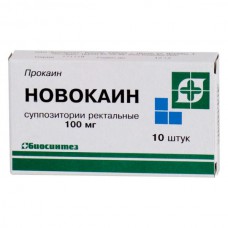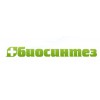Expiration date: 10/2026
Pharmachologic effect:
Local anesthetic activity with moderate and great breadth of therapeutic action. Being a weak base, blocking sodium channels, calcium displaces from receptors located on the inner surface of the membrane and thereby prevents the generation of pulses in sensory nerve endings and conduction of impulses along nerve fibers. Changes the action potential in the membranes of nerve cells without the expressed influence on the resting potential. It suppresses holding not only the pain but also other pulses. Modality. When suction and introduced into direct vascular blood flow reduces the excitability of peripheral cholinergic systems, and reduces the formation of acetylcholine release from the preganglionic endings (ganglioblokiruyuschim has some action), smooth muscle spasm eliminates, reduces the excitability of the myocardium and motor areas of the cerebral cortex. The on / in the introduction has analgesic, antishock, anti-hypertensive and anti-arrhythmic effects (increases the effective refractory period, reduces the excitability, automatism and conductivity), may interfere with neuromuscular conductivity at high doses. Eliminates the descending inhibitory influences of the reticular formation of the brain stem. It inhibits polisinapticheskie reflexes. In large doses can cause convulsions. It has a short anesthetic activity (infiltration anesthesia duration is 0.5-1 hours). When i / m administration is effective in elderly patients in the early stages of diseases associated with functional CNS disorders (hypertension, spasms of the coronary vessels and the vessels of the brain, and others.).
Pharmacokinetics
Poorly absorbed through the mucous membranes. For parenteral administration, is well absorbed, it is rapidly hydrolyzed plasma and tissue esterases to form two major pharmacologically active metabolites: diethylaminoethanol (possesses moderate vasodilatory action) and para-amino benzoic acid (a competitive antagonist of sulfa drugs and chemotherapy may weaken their antimicrobial effect). T1 / 2 - 0.7 minutes. Write mainly kidneys as metabolites - 80%.
Indications:
Infiltration (including intraosseous), conduction, epidural, spinal anesthesia, anesthesia of the mucous membranes (ENT), vagosympathetic and perirenal blockade, late toxicosis of pregnancy with hypertension, vasospasm (for removing spasms of peripheral blood vessels and improve microcirculation in frostbite doreaktivnom in the period), phantom pain. For the preparation and during general anesthesia and postoperative period (to relieve pain and spasms). To dissolve the penicillin (to elongation expires). Endarteritis, obliterating atherosclerosis of the lower extremities, koronarospazm, spasm of cerebral arteries, rheumatic diseases of joints and infectious origin. Rectal: hemorrhoids, intestinal colic, anal fissures, and nausea. Rarely - gastric ulcer and duodenal ulcer, ulcerative colitis, itchy skin (atopic dermatitis, eczema), keratitis, iridocyclitis, glaucoma, hypertension.
Contraindications:
Hypersensitivity, children's age (12 years). Emergency operation, accompanied by acute blood loss. Severe fibrotic changes in the tissues (for anesthesia by creeping infiltration).
Dosage and administration:
Solution d / in: For infiltration anesthesia - 0.25-0.5% solutions, anesthesia method Vishnevsky (tight creeping infiltration) - 0.125-0.25% solutions for conduction anesthesia - 1-2% solutions for epidural - 2% solution (20 -25 ml) for spinal - 5% solution (2.3 ml) for anesthesia of mucous membranes in otolaryngology - 10-20% solution. To reduce elongation and suction action at the local anesthetic is further added a solution of 0.1% epinephrine hydrochloride - 1 drop per ml procaine 2-5-10 solution. When perirenal blockade (by A. Wisniewski) perirenal fat administered in 50-80 ml of 0.5% solution of 100-150 mL or 0.25% solution, and at vagosympathetic blockade - 30-100 ml of 0.25% solution. In arterial hypertension, late toxicosis pregnant women with hypertension, arterial spasm, phantom pains, gastric ulcer and duodenal ulcer, ulcerative colitis - a / c, 1 to 10-15 mL 0.25-0.5% solution, slowly, in 0.9% sodium chloride solution. The number of injections (10-20) depending on the disease severity and treatment efficacy. When atrial fibrillation (in connection with the ability to reduce the excitability of the heart muscle) - in / at 2-5 ml 0.25% solution (4-5 times). For spasmolysis peripheral vessels and improving microcirculation in frostbite (in doreaktivnom shown) suggested a mixture administered in / and consisting of 10 ml 0.25% procaine solution, 2 ml of 2% papaverine solution, 2 ml of a 1% solution of nicotinic acid and 10,000 IU of heparin . For treatment endarteritis, atherosclerosis, hypertension, coronary spasm and cerebral blood vessels, rheumatic joint diseases and infectious origin introducing / m, 5 ml of 2% solution of procaine three times a week, for a course - 12 injections, and then make a 10 day break. Treatment is carried out in a hospital environment. During the year the treatment is repeated 4 times. The effect is observed mainly in the early stages of the disease. For circular and paravertebral blockade with eczema, atopic dermatitis and sciatica - w / c, 0.25-0.5% solution. 10% solution is also used for electrophoretic injection. Inside, 0.25-0.5% solution to 30-50 ml, 2-3 times a day. Higher doses of procaine (adult): single ingestion - 0.25 g / m 2% solution - 0.1 g (5 ml) / 0.25% solution - 0.05 g (20 ml), the daily ingestion -0.75 g / m and / in - 0.1 g higher doses for adults for infiltration anesthesia: one single dose at the beginning of the operation - not exceeding 1.25 g 0.25% solution (using a 0.25% solution - 500 ml) and 0.75 g of 0.5% solution (150 mL). Subsequently, every hour during the operation - not more than 2.5 g (1000 ml of 0.25% solution) and 2 g (400 ml of 0.5% solution).
Candles: Rectal. Pre freeing the contour of the candle package with scissors (cutting contour packaging suppositories), it is introduced deeply into the anus (after enema or spontaneous bowel release) 1 - 2 times a day.
Side effects.
Dizziness, weakness, decreased blood pressure, collapse, shock, allergic reactions (dermatitis, peeling skin). Overdose. Symptoms: pale skin and mucous membranes, dizziness, nausea, vomiting, cold sweats, shortness of breath, tachycardia, decreased blood pressure up to the collapse. The action on the central nervous system manifests a sense of fear, hallucinations, convulsions, motor excitation. Treatment: maintenance of adequate pulmonary ventilation with oxygen inhalation, in / with the introduction of short funds for general anesthesia, in severe cases - detoxification and symptomatic therapy.
Special instructions:.
Is not absorbed from mucous membranes, does not provide surface anesthesia.
Drug interactions
With on / in a dampening effect on the central nervous system agents for general anesthesia, hypnotics, sedatives, tranquilizers and narcotic analgesics. Procaine metabolite (para-aminobenzoic acid) is an antagonist of antimicrobial sulfonamides.


